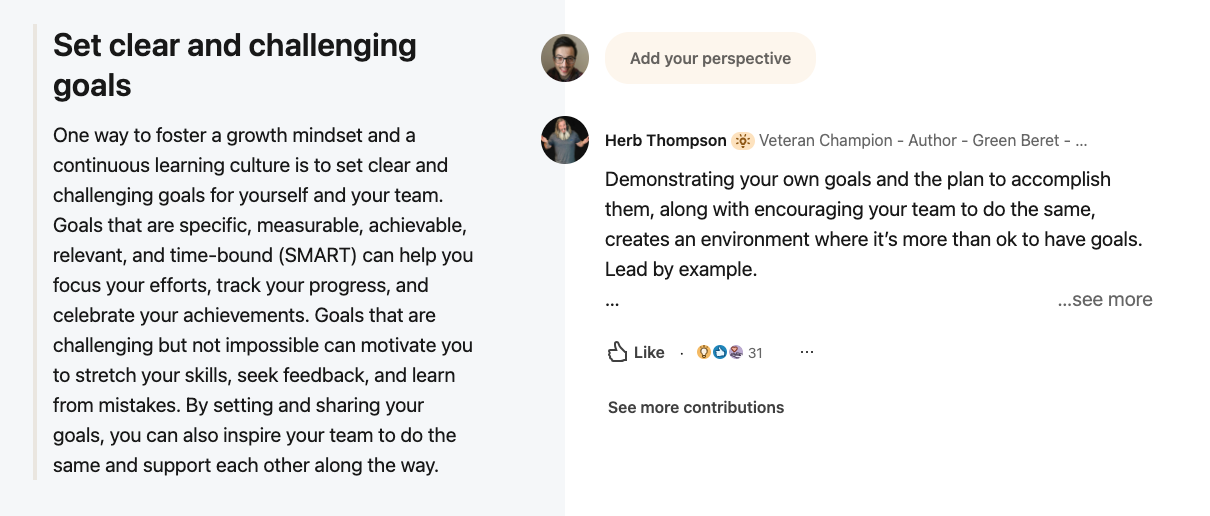
LinkedIn has been testing various ways to help journalists build their profile and presence on the platform. Its latest effort is 'collaborative articles'. Check your LinkedIn messages and you might find a personal invitation.
The platform rolled out collaborative articles in March. These articles are generated initially by AI and then tweaked by the editorial team. This can be on a wide range of professional topics, like calming public speaking nerves, managing burnout and so on. Head to the collaborative article section, filter by sector and start browsing.
They are like blog posts with the ability to comment on different sections. Only, LinkedIn is selective over who can have their say and they want journalists to join the party.
"Journalists and media professionals bring deep subject matter expertise and knowledge across a vast array of topics to LinkedIn’s community," says Julien Wettstein, head of editorial, EMEA at LinkedIn in an email to Journalism.co.uk.
What's in it for journalists? Good question. LinkedIn says journalists can expect to grow their following and reach new audiences by getting involved. There may also be some prestige up for grabs.
People can earn a light gold Community Top Voices badge if they become one of the top contributors for a particular skill or topic. This is awarded for consistent contributions that are "relevant, original, and additive". The badge expires after 60 days if users cannot keep up this commitment. Users can have multiple badges for different topics, all of which are subject to the same rules and guidelines.

Note: this is not to be confused with the LinkedIn Top Voices (formerly the LinkedIn influencer program), which is a blue badge on your profile or next to a comment.
The Community Top Voices is a shortcut for newcomers and time-poor users to achieve some standing on the platform. Posting a comment is easier than creating original content. LinkedIn confirmed that nearly half of collaborative article contributors are members who are not regular content creators.
Wettstein points to the LinkedIn for Journalists programme, a dedicated place for training and resources, and LinkedIn News, which curates and amplifies journalists' articles, as other ways LinkedIn wants to attract journalists. No signs of opportunities to monetise content, though.
Cachet in exchange for commitment
Juliana Chan is a Singaporean media entrepreneur, formerly a biomedical researcher with a Ph.D. degree in Biology from MIT. In 2018, she walked away from a tenure-track academic career to pursue social impact through science communication.
Today, she is the founder and CEO of Wildtype Media Group, Asia's leading STEM-focused media company and publisher of Asian Scientist Magazine, an award-winning science and technology title that highlights Asian research and development news stories.
In November 2020, she was among 16 experts chosen to be a part of the inaugural cohort of LinkedIn's Top Voices for Singapore. The selection process is a qualitative and quantitative assessment of user posts over a 12-month period.
Chan has 68k followers on LinkedIn. Being a Top Voice, she says, is attractive for potential clients and a welcome confidence boost in her ability. However, she has found other features more beneficial. This includes appearing in LinkedIn's weekly newsletters and speaking opportunities given by the platform.
She has been invited to participate in the collaborative articles but has not yet jumped in. She praised efforts to democratise who can be a 'Top Voice' on the platform, even though it requires significant input from the user.
"LinkedIn’s editorial strategy is to reward content creators who invest significant amounts of time, painstaking effort and energy into posting quality content on its platform," Chan says in an email to Journalism.co.uk.
"I am heartened that LinkedIn is finding more and more ways to reward their content creators. If LinkedIn treats its creators well, all of us will reciprocate with renewed enthusiasm and invest even more time into creating content for the platform. That's the law of reciprocity for you."
Free daily newsletter
If you like our news and feature articles, you can sign up to receive our free daily (Mon-Fri) email newsletter (mobile friendly).
Related articles
- LinkedIn newsletters: are they what they are cracked up to be?
- Six self-care tips for journalists to stay sane during the general election
- RISJ Digital News Report 2024: Three essential points for your newsroom
- Five things lecturers wish they knew before teaching journalism
- Newsrewired sneak peek: the guide to life after the newsroom, with Alison Gow and Mark Frankel









